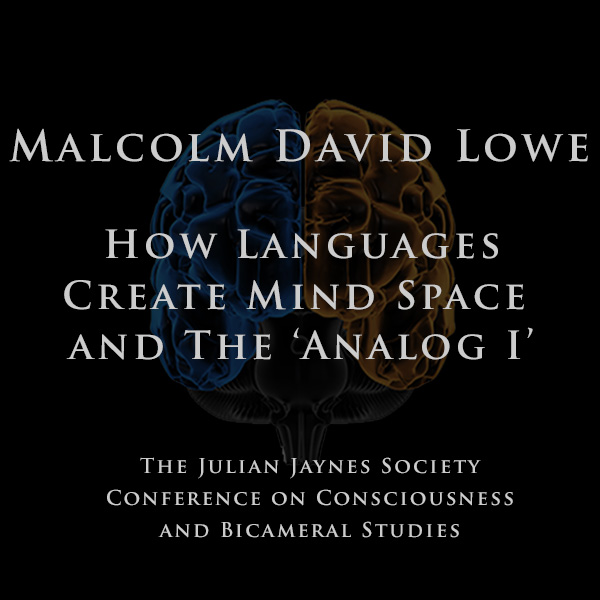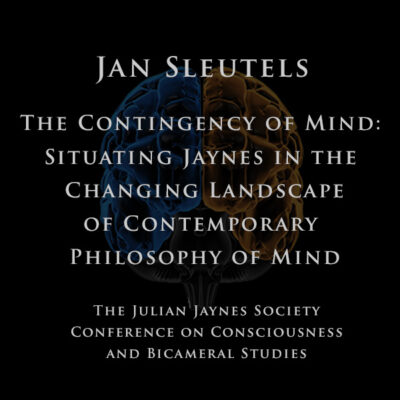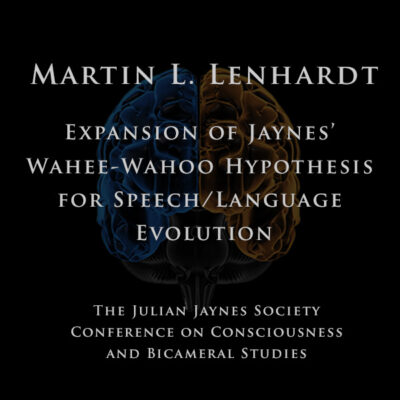Description
Audio download of Malcolm David Lowe’s lecture “How Languages Create Mind Space and The ‘Analog I’.”
From the Julian Jaynes Society Conference on Consciousness and Bicameral Studies.
Summary: The idea that consciousness is built on the back of language is one of the four pillars of Julian Jaynes’s (JJ) ‘preposterous hypothesis’ advanced in his epic work The Origin of Consciousness in the Breakdown of the Bicameral Mind (OC). JJ discusses at length how metaphor has the capacity to generate mind space. It is a central theme of his book and one that you are probably quite familiar with. In this paper, I intend to turn back the hands of time and suggest that while metaphor may have expanded a mind space that already existed, it is an ancient design feature of language itself that first gives rise to mind space and the ‘analog I’.
Before I can do that, however, there is one obstacle that I have to address and it has to do with the way we perceive language. For over three hundred years, we have studied the forms of language — its sounds, morphology, words, grammar and syntax — in much the same way that an entomologist pins down a specimen for examination. It’s called the scientific method. In the process we have turned languages into assemblages of desiccated specimens. But languages are more than that. They are dynamic living systems which, while always in flux, exhibit a definite architecture. In other words, they are more than the sum of their parts. At any given point in time they represent a complex coherent system of meaning/sound relations. Changing the reductionist lens for a more holistic one will allow us to view language in an altogether different light and one that is more receptive to my line of inquiry.
While every language weaves the threads of meaning and sound together in its own way to produce a unique and intricate tapestry, the operational logic at work in the unconscious does not change in the lifetime of a language system. Thus there is a direct lineage between the present day variety of a language and the emergent system at its genesis. If this were not the case, how could we account for the continuity of English through such radically different forms as are represented by Old English, Middle English and modern English? So when we look at the patterns generated by sound and meaning in any language, we are looking at a very ancient architecture. It precedes all the trappings of syntax, in its narrow sense, and grammar, both of which represent later developments in the life of a language. But here we run into a problem. We cannot see this architectural detail because the threads of sound and meaning are woven together in an unseen matrix in the unconscious. Fortunately for us, however, although the matrix is not directly accessible to our conscious mind, its architecture can be discerned by looking at the meaning/sound patterns manifested in words, which carry this ancient DNA in their architecture. Each of the word pairs listed on page 3 of this abstract confirm that there is such a level of meaning operating in the background of words. Words are simply downstream expressions of this generative matrix of sound and meaning. At first it may seem like we are just playing word games here, but once you start to see the underlying sound/meaning patterns behind the words, the pervasive nature of these patterns becomes increasingly obvious.
There are a number of different explanations you could posit for these sound and meaning correlations. One is that the examples offered are, in the words of linguist John McWhorter, “the result of largely random accretions through the millennia….” Another explanation is that the patterns are interesting but not significant. A third approach, and one that I will advocate for, is that these are not chance correlations and, further, that they are extremely significant. I will argue that far from being “random accretions”, these twinned pairs of meaning and sound point to a basic organizing principle of language, to wit that meaning is organized in polarities. To couch this in other terms, if you were to be magically relieved of your ability to think in terms of polarities — in other words, if you could no longer contrast “up” with “down”, “left” with “right”, “male” with “female”, “black” with “white”, or “me” with “not me,” then you would no longer be conscious in the Jaynesian sense. I will attempt to convince you, with the aid of the specific examples mentioned, and others, that polarity of meaning is what creates the “other” described in the quotation at head of this abstract. Without it there would be no mind space and no ‘analog I.” Accenting this perspective on language opens up a whole new window of understanding into the nature of language and languages, and portends a fundamental realignment in our thinking about the origins of language and consciousness.
All audio files are in mp3 format. Upon payment you will receive a link to download the file.




